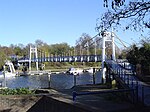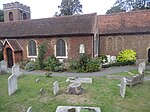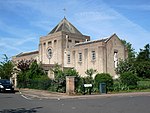Lensbury Sports Ground
Cricket grounds in LondonEnglish cricket ground stubsLondon sports venue stubsSport in the London Borough of Richmond upon ThamesSports venues completed in 1932 ... and 1 more
Use British English from February 2023
Lensbury Sports Ground is a cricket ground in Teddington, London (formerly Middlesex). The first recorded match on the ground was in 1932, when Affiliated South American Banks played the South Americans. From 1982 to 1998, the ground held a combined total of 17 Second XI fixtures for the Middlesex Second XI in the Second XI Championship and Second XI Trophy.In 1979, the ground held a single Women's One Day International between England women and West Indies women.In local domestic cricket, the ground is the home venue of St. Mary's University College cricket team.
Excerpt from the Wikipedia article Lensbury Sports Ground (License: CC BY-SA 3.0, Authors).Lensbury Sports Ground
Marston Road, London Hampton Wick (London Borough of Richmond upon Thames)
Geographical coordinates (GPS) Address Nearby Places Show on map
Geographical coordinates (GPS)
| Latitude | Longitude |
|---|---|
| N 51.42675 ° | E -0.32138 ° |
Address
Marston Road
TW11 9JU London, Hampton Wick (London Borough of Richmond upon Thames)
England, United Kingdom
Open on Google Maps










